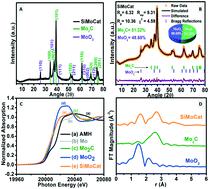当前位置:
X-MOL 学术
›
Catal. Sci. Technol.
›
论文详情
Our official English website, www.x-mol.net, welcomes your
feedback! (Note: you will need to create a separate account there.)
In situ modulation of silica-supported MoO2/Mo2C heterojunction for enhanced hydrogen evolution reaction
Catalysis Science & Technology ( IF 4.4 ) Pub Date : 2020-06-08 , DOI: 10.1039/d0cy00890g Rajinder Kumar 1, 2, 3 , Zubair Ahmed 1, 2, 3 , Ravi Kumar 3, 4, 5, 6 , Shambhu Nath Jha 3, 4, 5, 6 , Dibyendu Bhattacharyya 3, 4, 5, 6 , Chandan Bera 1, 2, 3 , Vivek Bagchi 1, 2, 3
Catalysis Science & Technology ( IF 4.4 ) Pub Date : 2020-06-08 , DOI: 10.1039/d0cy00890g Rajinder Kumar 1, 2, 3 , Zubair Ahmed 1, 2, 3 , Ravi Kumar 3, 4, 5, 6 , Shambhu Nath Jha 3, 4, 5, 6 , Dibyendu Bhattacharyya 3, 4, 5, 6 , Chandan Bera 1, 2, 3 , Vivek Bagchi 1, 2, 3
Affiliation

|
Hydrogen being a promising source of clean energy, the production of hydrogen using electrocatalysis and the development of carbon-neutral energy conversion technologies are crucial. Lately, electrocatalysts with multiple solid–solid heteroatom interfaces have been gaining importance due to their improved HER activity. Herein, a mesoporous composite of molybdenum carbide and molybdenum oxide on a silica platform (SiMoCat) was developed, which exhibited an overpotential of 71 mV to drive a current density of 10 mA cm−2, very close to the commercially available Pt/C (η10 = 60 mV), and a Tafel slope value of 35 mV dec−1 with an onset potential of 31 mV. Even after 3500 catalytic cycles, SiMoCat was found to be quite stable and did not show any significant change in the catalytic activity. SiMoCat was obtained by judicious variation in the catalyst precursor and the reaction conditions, resulting in a composition containing 51.32% Mo2C and 48.68% MoO2. Theoretical studies revealed that the integration of Mo2C and MoO2 heterostructure with SiO2 substrate enhances the surface charge distribution of the SiMoCat interface and assists the formation of an energetically active catalytic region. The values of ΔGH* on the C, Mo (∼1.9 eV, ⋍2.44 eV) and O, Mo (⋍0.54 eV, ⋍2.29 eV) sites of Mo2C/MoO2 of SiMoCat are optimized as the effect percolates through the nanolayers and hence the H* adsorption kinetics of the interface are better than those of the individual systems.
中文翻译:

二氧化硅负载的MoO2 / Mo2C异质结的原位调制以增强析氢反应
氢是一种有希望的清洁能源,利用电催化生产氢和开发碳中和能量转换技术至关重要。最近,具有多个固体-固体杂原子界面的电催化剂由于其HER活性的提高而变得越来越重要。本文开发了一种在二氧化硅平台(SiMoCat)上的碳化钼和氧化钼介孔复合材料,该复合材料表现出71 mV的过电势,可驱动10 mA cm -2的电流密度,非常接近市售Pt / C(η 10 = 60毫伏),和35毫伏分解的塔菲尔斜率值-1起始电位为31 mV。即使经过3500次催化循环,SiMoCat仍然非常稳定,并且催化活性没有任何明显变化。通过适当地改变催化剂前体和反应条件获得SiMoCat,得到的组合物包含51.32%的Mo 2 C和48.68%的MoO 2。理论研究表明,Mo 2 C和MoO 2异质结构与SiO 2衬底的集成增强了SiMoCat界面的表面电荷分布,并有助于形成能量活性催化区。Mo的C,Mo(〜1.9 eV,⋍2.44eV)和O,Mo(⋍0.54eV,⋍2.29eV)位点上的ΔG H *值优化了SiMoCat的2 C / MoO 2,因为该效果渗入了纳米层,因此界面的H *吸附动力学优于单个系统。
更新日期:2020-07-21
中文翻译:

二氧化硅负载的MoO2 / Mo2C异质结的原位调制以增强析氢反应
氢是一种有希望的清洁能源,利用电催化生产氢和开发碳中和能量转换技术至关重要。最近,具有多个固体-固体杂原子界面的电催化剂由于其HER活性的提高而变得越来越重要。本文开发了一种在二氧化硅平台(SiMoCat)上的碳化钼和氧化钼介孔复合材料,该复合材料表现出71 mV的过电势,可驱动10 mA cm -2的电流密度,非常接近市售Pt / C(η 10 = 60毫伏),和35毫伏分解的塔菲尔斜率值-1起始电位为31 mV。即使经过3500次催化循环,SiMoCat仍然非常稳定,并且催化活性没有任何明显变化。通过适当地改变催化剂前体和反应条件获得SiMoCat,得到的组合物包含51.32%的Mo 2 C和48.68%的MoO 2。理论研究表明,Mo 2 C和MoO 2异质结构与SiO 2衬底的集成增强了SiMoCat界面的表面电荷分布,并有助于形成能量活性催化区。Mo的C,Mo(〜1.9 eV,⋍2.44eV)和O,Mo(⋍0.54eV,⋍2.29eV)位点上的ΔG H *值优化了SiMoCat的2 C / MoO 2,因为该效果渗入了纳米层,因此界面的H *吸附动力学优于单个系统。











































 京公网安备 11010802027423号
京公网安备 11010802027423号